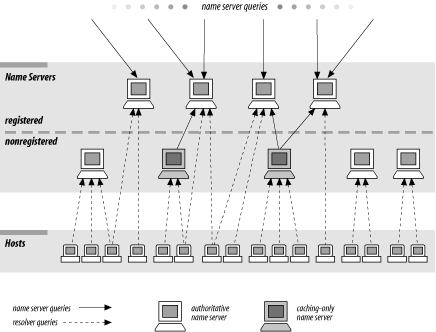Registering Name Servers
When you get around to setting up more and more name servers, a question may strike you—do I need to register all of my primary and slave name servers with my parent zone? The answer is no. Only those servers you want to make available to name servers outside of your zone need to be registered with your parent. For example, if you run nine name servers for your zone, you may choose to tell the parent zone about only four of them. Within your network, you use all nine servers. Five of those nine servers, however, are queried only by resolvers on hosts that are configured to query them. Their parent name servers don’t delegate to them, so they’ll never be queried by remote name servers. Only the four servers registered with your parent zone are queried by other name servers, including caching-only and partial-slave name servers on your network. This setup is shown in Figure 8-6.

Figure 8-6. Registering only some of your name servers
Besides being able to pick and choose which of your name servers are hammered by outside queries, there’s a technical motivation for registering only some of your zone’s name servers: there is a limit to how many servers will fit in a UDP response packet. In practice, around 10 name server records should fit. Depending on the data (how many servers are in the same domain), you can get more or fewer.[31] There’s not much point in ...
Get DNS on Windows 2000, Second Edition now with the O’Reilly learning platform.
O’Reilly members experience books, live events, courses curated by job role, and more from O’Reilly and nearly 200 top publishers.

